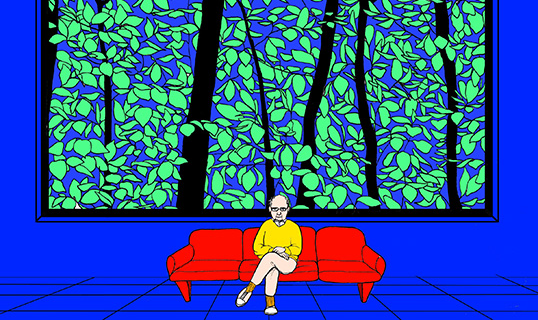Asymptote’s glorious Summer issue is chockablock with gems. Some of our section editors share their highlights:
“To assert that Tove Jansson’s invention of the Moomin world may be partially rooted in ancient lore is, for this writer, to fear performing an act of sacrilege,” confesses Stephanie Sauer in her essay on renowned Finnish author-artist, Tove Jansson. This confession is the crux of Sauer’s questionings. Journey with Sauer from the moment the Moomins were conceived, to its unlikely, subversive evolution. Hold tighter still as she dives into Jansson’s personal life, her questions of war, artistry, womanhood, and sexuality, and the fearless, unconventional course she cut through history.
—Ah-reum Han, Writers on Writers Editor
This issue features excerpts from two plays that deal with aspects of “disappearance” and surveillance. In Blanca Doménech’s The Sickness of Stone, translated from the Spanish by William Gregory, we take a look at a cold, dark world where random pieces of text read from discarded books become a kind of key to unlocking society’s ills or sickness. Gregory’s eloquent, tart translation finds the humor, bite and despair in this fascinating play.
In Hanit Guli’s Orshina, translated from the Hebrew by Yaron Regev, a father must decide how he will disappear from his family’s life and what he will or will not tell them. An odd, compassionate family drama, Regev’s translation of Guli’s one-act is evocative and clear.
—Caridad Svich, Drama Editor
The work of Mexico-born artist Enrique Chagoya playfully interrogates the subjects and styles of North American and Western European art, particularly modern art with its use of non-Western practices. M. René Bradshaw, Asymptote’s UK Editor-at-Large, introduces Chagoya’s “secret engine of postcolonial cunning” followed by an interview in which Chagoya discusses his artistic strategies, including his process of “reverse modernism,” a satirical reimagining of cultural influence. As Chagoya puts it, “I appropriate many Western artists from the perspective of a ‘primitive artist’ or ‘noble savage.’” The result, he states, is a “visual critique of this imbalance of power, and the many cultural stereotypes that may emerge from it (Western and non-Western).” Recent work responds to the xenophobia of U.S. President Donald Trump, and Asymptote’s slide show includes a very new work from the artist’s series-in-progress, The President’s Xenophobic Nightmare in a Foreign Language. Chagoya concedes, though, “the best caricature of Mr. Trump is Trump himself.”
—Eva Heisler, Visual Editor
Noemi Schneider’s Life as Trauma, superbly translated by Julie Winter, tells the story of the author’s encounter with both Binjamin Wilkomirski, a man who survived Nazi concentration camps and published a memoir about his experiences, and Bruno Grosjean, who was born in Biel in 1941, and adopted by a rich Zurich family. These two men are one and the same.
Schneider doesn’t pass judgment on Wilkomirski; his fictional memoir and assumed identity were tried in court and in the media. Rather, her haunting essay examines what it means to live a false life: can a false life be lived truthfully, or is it the case, as Adorno suggests, “Es gibt kein richtiges Leben im Falschen“ (A false life cannot be lived correctly). Through the story of Wilkomirski, Schneider explores a broader question: what, in the false, is true?
—Joshua Craze, Nonfiction Editor
Under the aegis of English lessons meant to prepare an illiterate woman from South India for America, stories from two different cultures are exchanged in B. Jeyamohan’s Periyamma’s Words, a “witty and heart-warming tale” picked by judge David Bellos to take top honors in the fiction category of this year’s Close Approximations translation contest (discover the other winners here). Don’t miss the inspiring podcast interview with emerging translator Suchitra Ramachandran, a post-doctoral neuroscientist based in Basel, Switzerland. Here’s a snippet: “I read it for the first time when it was published in 2015 [and] realised it’s both a translator’s dream and nightmare because it layers so many things and so many concepts and so many symbols one over the other. There’s also an inside joke in translating the story, because while the narrator is teaching Periyamma English within the story, in the act of translation, I’m trying to teach the readers of the story Tamil.”
—Lee Yew Leong, Fiction Editor and Editor-in-Chief
*****
Read more from the Asymptote team:

